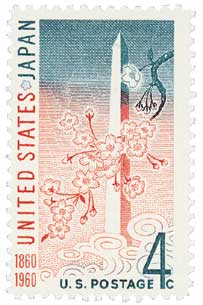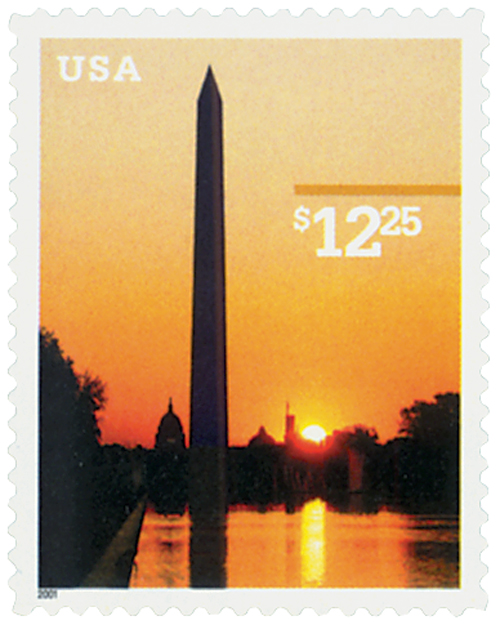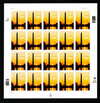
# 3473 - 2001 $12.25 Washington Monument
$12.25 Washington Monument
Express Mail
City: Washington, DC
Printed by: Derry Noyes
Printing Method: Photogravure
Perforations: 11 ¼ x 11 ¾
Color: Multicolored
Dedication Of The Washington Monument

On February 21, 1885, the Washington Monument was dedicated, 37 years after its cornerstone was laid.
In his lifetime, George Washington was a revered and respected man. Unanimously elected the first president of the United States, he created a national bank, collected taxes to cover expenses, and improved the Army and Navy. He even turned down a salary, only accepting money to cover his expenses. Washington was so popular in fact; that the people tried to get him to serve a third term, but the noble leader chose instead to retire to his peaceful Mount Vernon home.
When Washington died two years later, the people of American wanted to honor him. Within 10 days of the president’s death, John Marshall of Virginia suggested the creation of a tomb in the Capitol. However, there was no money for the project and Washington’s family refused to move his body.

Finally, in 1832, the 100th anniversary of Washington’s birth, a group of citizens formed the Washington National Monument Society. Within the first few years, they raised more than $28,000 and announced a competition to select the memorial design.
According to the board of managers, “It proposed that the contemplated monument shall be like him in whose honor it is to be constructed, unparalleled in the world, and commensurate with gratitude, liberality, and patriotism of the people by whom it is erected… It should blend stupendousness with elegance, and be of such magnitude and beauty as to be an object of pride to the American people, and of admiration to all who see it.”

The winning design, created by architect Robert Mills, called for a 600-foot obelisk (a tall, four-sided pillar that tapers near the top). Mills’ design also called for the obelisk to be surrounded by a circular colonnade topped with a statue of Washington in a chariot. Within the colonnade would be the statues of 30 notable Revolutionary War heroes. Many criticized the design and its $1 million proposed cost. The society decided to start building the obelisk and worry about whether or not to build the colonnade later. They believed that if they used the $87,000 they’d already raised, the progress on the monument would inspire more donations.
When Pierre L’Enfant created his plans for Washington, DC in 1791, he included a spot for an equestrian statue of Washington. However, after the design was selected, planners realized that the intended spot was too swampy and unstable to support such a massive and heavy structure. They then selected a new spot slightly southeast of the original with a “beautiful view of the Potomac and is “so elevated that the monument will be seen from all parts of the surrounding country.”
$12.25 Washington Monument
Express Mail
City: Washington, DC
Printed by: Derry Noyes
Printing Method: Photogravure
Perforations: 11 ¼ x 11 ¾
Color: Multicolored
Dedication Of The Washington Monument

On February 21, 1885, the Washington Monument was dedicated, 37 years after its cornerstone was laid.
In his lifetime, George Washington was a revered and respected man. Unanimously elected the first president of the United States, he created a national bank, collected taxes to cover expenses, and improved the Army and Navy. He even turned down a salary, only accepting money to cover his expenses. Washington was so popular in fact; that the people tried to get him to serve a third term, but the noble leader chose instead to retire to his peaceful Mount Vernon home.
When Washington died two years later, the people of American wanted to honor him. Within 10 days of the president’s death, John Marshall of Virginia suggested the creation of a tomb in the Capitol. However, there was no money for the project and Washington’s family refused to move his body.

Finally, in 1832, the 100th anniversary of Washington’s birth, a group of citizens formed the Washington National Monument Society. Within the first few years, they raised more than $28,000 and announced a competition to select the memorial design.
According to the board of managers, “It proposed that the contemplated monument shall be like him in whose honor it is to be constructed, unparalleled in the world, and commensurate with gratitude, liberality, and patriotism of the people by whom it is erected… It should blend stupendousness with elegance, and be of such magnitude and beauty as to be an object of pride to the American people, and of admiration to all who see it.”

The winning design, created by architect Robert Mills, called for a 600-foot obelisk (a tall, four-sided pillar that tapers near the top). Mills’ design also called for the obelisk to be surrounded by a circular colonnade topped with a statue of Washington in a chariot. Within the colonnade would be the statues of 30 notable Revolutionary War heroes. Many criticized the design and its $1 million proposed cost. The society decided to start building the obelisk and worry about whether or not to build the colonnade later. They believed that if they used the $87,000 they’d already raised, the progress on the monument would inspire more donations.
When Pierre L’Enfant created his plans for Washington, DC in 1791, he included a spot for an equestrian statue of Washington. However, after the design was selected, planners realized that the intended spot was too swampy and unstable to support such a massive and heavy structure. They then selected a new spot slightly southeast of the original with a “beautiful view of the Potomac and is “so elevated that the monument will be seen from all parts of the surrounding country.”












